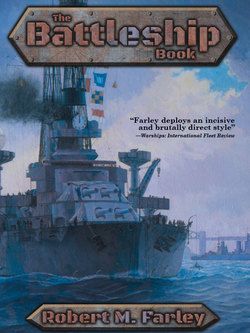Читать книгу The Battleship Book - Robert M. Farley - Страница 15
На сайте Литреса книга снята с продажи.
ОглавлениеUSS Michigan
Laid Down: 1905
Launched: 1906
Completed: May, 1908
Displacement: 16,000 tons
Main Armament: eight 12” guns (four twin turrets)
Secondary Armament: twenty-two 3” guns (individual mounts)
Speed: 18.5 knots
Major Actions: None
Treaty: Pre-Washington Naval Treaty
Fate: Scrapped, 1924
Dreadnought was the first modern battleship completed, but not the first designed. That honor went to a pair of American battleships, South Carolina and Michigan. Congress limited the size of Michigan to more-or-less the same as that of the Connecticut class pre-dreadnought battleships, 2,500 tons smaller than Dreadnought. Onto that small frame the architects managed to pack eight 12” guns in four twin turrets. Larger only than the España class dreadnoughts, Michigan minimally, if efficiently, fulfilled the requirements of the dreadnought form.
Collapsed cage mast, January 28, 1918. US Naval Historical Center.
The most advanced element of the design was turret distribution. While most other navies played with wing turrents (gun turrets set off the center line, and thus incapable of firing a broadside in either direction), Michigan was built with superfiring turrets, where the second turret on each side of the ship was elevated above the first. This allowed all of the guns to fire in a broadside in either direction. The Royal Navy and others believed that the blast from the lower gun would throw off the aim of the upper, but tests on the American ships were very successful. This arrangement was maintained in the rest of the US battleship fleet, and eventually spread to the rest of the world’s navies.
Unfortunately, because of her small size Michigan lacked the machinery to make more than 18 knots. Dreadnought, on the other hand, could make 21 knots. The next class of American battleships (and all that followed them) could also make 21 knots, which had the effect of rendering South Carolina and Michigan obsolete shortly after their completion. Unable to keep up with the main US battle squadron, Michigan generally operated with squadrons of pre-dreadnoughts.
USS Michigan underway, 1918. Enrique Muller, War Department photo.
Michigan and South Carolina were also notable for being the first US battleships constructed with cage masts. Earlier US ships had been built with more conventional masts, although by 1910 most had been refitted with cage masts. Cage masts distinguished American ships from those of any other navy in the world. They were extremely fire resistant (shells simply passed through them), but tended to restrict angles of fire for anti-aircraft guns, although this was not an important consideration in 1908. Every battleship up until West Virginia (completed in 1922) carried cage masts. The experience of Michigan also, indirectly, helped lead to the end of the cage mast era. In 1918, gale force winds bent the forward mast of Michigan all the way down to the deck, killing six men and injuring twice as many. US battleships modernized during the interwar period lost their cage masts, although four of the ships at Pearl Harbor (California, Tennessee, Maryland, and West Virginia) still had theirs on the day of the attack. Two ships (Maryland and Colorado) would retain their cage masts all the way until their disposal dates in 1959.
In any case, Michigan never saw combat outside of the action off Vera Cruz in 1914, when Woodrow Wilson unleashed most of the firepower of the US Navy against a small Mexican city. In World War I, Michigan conducted convoy escort and training ops. Michigan was taken out of service shortly after World War I, and was scrapped under the requirements of the 1922 Washington Naval Treaty.
Author’s Note
Michigan was a nice, well-designed little battleship, more of a coda to the pre-dreadnought era than an introduction to the new form. US battleship architects habitually underrated speed relative to armor and armament. While other states had begun to develop fast pre-dreadnoughts, the United States built slow dreadnoughts. The US built no battlecruisers, and kept tight parameters for the speed of the “standard type” battleships.
But oh, the glory of cage masts. Unlike superfiring turrets, these were a design dead end. But nevertheless, the era of cage masts was wonderful from an aesthetic point of view. The masts set US dreadnoughts visually apart from all of their foreign contemporaries, lending a sense of uniqueness and authenticity to the American battlefleet. It’s too bad they collapsed in strong winds, were bad for anti-aircraft fire, and had a variety of other fatal problems.
USS Michigan in 1912. National Archive and Records Administration.
Related Entries:
Contemporary of… HMS Dreadnought
Preceded… USS Utah
Inspired… SMS Viribus Unitis
